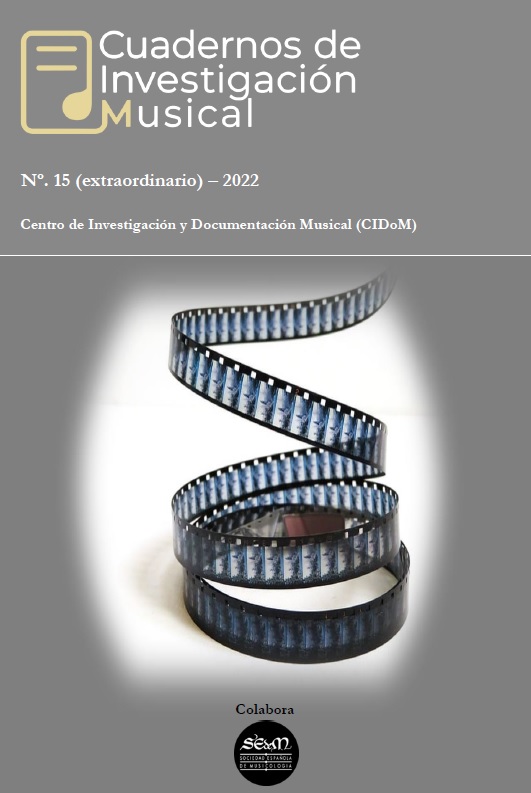“It’s music, a human thought structure” La música como tecnología de los cyborgs en el cine cyberpunk Español
Contenido principal del artículo
Resumen
En este artículo, analizo cómo dos películas españolas de cyberpunk, Eva y Autómata, imaginan cyborgs y representan la música como parte de sus capacidades relacionales con artefactos, entidades y entornos. A través de un análisis interconectado, presento la idea de la ecología musical como una articulación entre las convenciones sonoras del cyberpunk y la música preexistente. Otro tema es el sujeto post-humano, al que denomino ensamblaje música-cyborgs donde los fenómenos sonoros son un agente intrínseco y activo de su construcción. La principal conclusión es que la música es una metáfora de la humanidad y un canal hacia nuevos modos de subjetividad destinados a reconfigurar la producción musical, la escucha, la interpretación y el placer.
Detalles del artículo
Los autores de los artículos mantienen el copyright, no recibirán ninguna contraprestación económica por el trabajo y el mismo siempre será reconocido como exclusivamente suyo. La revista se compromete a proteger la integridad y originalidad del artículo, así como los derechos de autor que correspondan. Los autores son los únicos responsables del material, textos e imágenes que utilizan en sus respectivos trabajos, debiendo respetar siempre los derechos de autor de terceras personas, por lo que la revista no se hace responsable de lo contenido en este tema respecto al trabajo de los autores.
Citas
Barham, J. (2000). Scoring Incredible Futures: Science-Fiction Screen Music, and “Postmodernism” as Romantic Epiphany. The Musical Quarterly, 91(3-4), pp. 240-274.
Bartkowiak, M. J. (2009). Introduction. In M. J. Bartkowiak (Ed.). Sounds of the Future: Essays on Music in Science Fiction Film (pp. 1-9). Jefferson: McFarland & Company, Inc., Publishers.
Braidotti, R. (2013). The Posthuman. Cambridge: Polity Press.
Brett, P. (2006). Musicality, Essentialism, and the Closet. In P. Brett, E. Wood & G. C. Thomas (Eds.). Queering the Pitch: The New Gay and Lesbian Musicology (pp. 9-26). New York and London: Routledge.
Buhler, J. (2019). Theories of the Soundtrack. Oxford: Oxford University Press.
DeNora, T. (2000). Music In Everyday Life. Cambridge: Cambridge University Press.
DeNora, T. (2011). Music-in-Action: Selected Essays in Sonic Ecology. London and New York: Routledge.
Fink, R. (2005). Repeating Ourselves: American Minimal Music as Cultural Practice. Berkeley: University of California Press.
Frith, S. (2003). Music and Everyday Life. In M. Clayton, T. Herbert & R. Middleton (Eds.). The Cultural Study of Music: A Critical Introduction (pp. 92-101). New York and London: Routledge.
Haraway, D. (2013). Staying with the Trouble: Making Kin in the Chthulucene. Durham and London: Duke University Press.
Hoeckner, B. (2007). Transport and Transportation in Audiovisual Memory. In D. Goldmark, L. Kramer & R. Leppert (Eds.). Beyond the Soundtrack: Representing Music in Cinema (pp. 163-183). Berkley, Los Angeles and London: University of California Press.
Kassabian, A. (2001). Hearing Film: Tracking Identifications in Contemporary Hollywood Film Music. New York and London: Routledge.
Lieb, K. J. (2018). Gender, Branding, and the Modern Music Industry. New York and London: Routledge.
Loza, S. (2001). Sampling (Hetero)Sexuality: Diva-Ness and Discipline in Electronic Dance Music. Popular Music, 20(3) [Gender and Sexuality (Oct., 2001)], pp. 349-357.
Malhado, A. (2021). A música na construção de práticas representacionais e estereotipadas do pós-humano em audiovisuais. In A. B. de Oliveira, A. C. Pereira, A. Taunay, L. Rosa & N. Araújo (Eds.). Cinema e Outras Artes IV: Diálogos e Inquietudes Artísticas (pp. 165-190). Covilhã: LabCom.
Marsh, C. & M. West. (2003). The Nature/Technology Binary Opposition Dismantled in the Music of Madonna and Björk. In R. T. A. Lysloff & L. C. Gay Jr. (Eds.). Music and Technoculture (pp. 182-203). Middletown: Wesleyan University Press.
McClary, S. (2000). Conventional Wisdom: The Content of Musical Form. Berkeley: University of California Press.
Neil L. (2009). Danny Elfman: ‘Funny Circus Mirrors’. In G. Harper (Ed.). Sound and Music in Film and Visual Media (pp. 524-532). New York: Bloomsbury.
Schmidt, L. M. (2009). A Popular Avant-Garde: The Paradoxical Tradition of Electronic and Atonal Sounds in Sci-Fi Music Scoring. In M. J. Bartkowiak (Ed.). Sounds of the Future Essays on Music in Science Fiction Film (pp. 22-43). Jefferson: McFarland & Company Inc. Publishers.
Shine, J. (2021). There’s meth in the madness: music and incongruence in AMC’s Breaking Bad. In A. Cascelli & D. Condon (Eds.). Experiencing Music and Visual Cultures: Threshold, Intermediality, Synchresis (pp. 153-166). London and New York: Routledge.
Short, S. (2005). Cyborg Cinema and Contemporary Subjectivity. New York: Palgrave MacMillan.
Small, C. (1999). Musicking: The Meanings of Performing and Listening. Middletown: Wesleyan University Press.
Smith, J. (2008). Vocal Tracks: Performance and Sound Media. Berkeley, Los Angeles and London: University of California Press.
